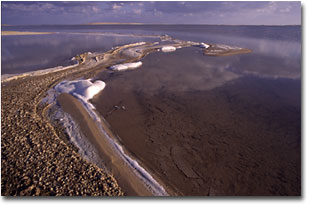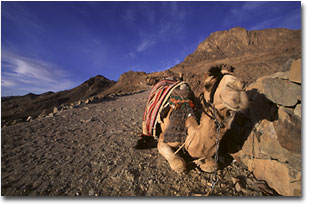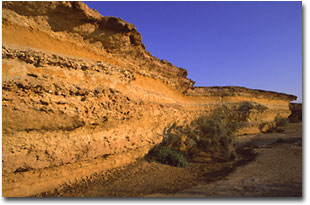
Outdoor photographers are always looking for new way to enliven their creativity. Too often we become acquainted with certain focal lengths, and tend to shoot most of our photographs with the same lens or lenses. Eventually we hit a plateau or a rut, with our images. Although great alone, they often have the same look as the rest of our images.
Ultra-wide angle lenses provide a way for photographers to add impact and a new look to their images. I can remember when I first tried an ultra-wide angle lens, I found it difficult to compose landscapes with such a wide angle of view. Unwanted clutter such as branches or even my tripod legs often appeared in the frame. If it was not the clutter, it was the lack of a point of interest in the image, as it seemed that the whole world was included in the photograph. However, ultra wide-angle lenses, when used properly, can create impact 3-D like images.
If you have never used a wide angle before, then you’d probably be surprised what a difference a decrease of 4 mm from a 24 mm to 20 mm or a 2 mm decrease from a 17 mm to 15 mm, makes. The opportunity to experiment with these different focal lengths in a single lens was not possible until the arrival of Sigma’s 15-30 mm f3.5-4.5 EX Aspherical DF DG lens.
Specs
- 17 elements in 13 groups
- 110.5 to 71.6 angle of view
- 8 diaphragm blades
- Minimum focusing distance of 11.8 inches at all focal lengths
- 1:6 maximum magnification
- 3.42 inches (diameter) x 5.12 inches (length)
- Weight: 21.8 oz
Hands on
 The lens has a solid feel, is somewhat large, but lightweight (a plus) considering its size. It has Sigma’s traditional black matte EX finish with the gold EX band around the focusing ring. The large, ribbed, rubber grip on both focusing and zoom rings, provide for responsive manual focusing and zooming. Also, the depth of field scale on the lens is for the 15 mm focal length.
The lens has a solid feel, is somewhat large, but lightweight (a plus) considering its size. It has Sigma’s traditional black matte EX finish with the gold EX band around the focusing ring. The large, ribbed, rubber grip on both focusing and zoom rings, provide for responsive manual focusing and zooming. Also, the depth of field scale on the lens is for the 15 mm focal length.
The lens includes a non-removable petal shaped hood and a metal filter holder and lens cap protect the front element when the lens is not in use. The lens uses gelatin filters that insert in the rear of the lens. Screw in filters that attach to the front of the lens, can also be used, but only at the 30 mm focal length. At shorter focal lengths, severe vignetting will occur.
In the Field
Although the lens is designated for use with digital cameras, being the widest zoom on the market, it is equally impressive with film cameras. The lens balanced well and felt comfortable in my hand with the following Canon bodies EOS 3, 1n, and Elan IIe. While this lens is not equipped with a hypersonic mount, autofocusing was responsive and fast.
When closely focused on an object in the foreground, the extreme large angle of view of an ultra wide-angle lens, makes it possible to create dramatic landscapes that convey depth, since objects in the foreground appear larger than they really are in relation to the background. This is important to me in creating those 3-D like images in which a point of interest (such as a lizard, small mammal, or flowers), pops out in the foreground, with the background being used to depict its natural surroundings. When shooting at an ultra-wide angle, you can also capture landscapes with depth of field from the foreground of less than a foot to infinity, especially when using smaller apertures.
As with most ultra-wide lenses, flare may be a problem when shooting at the direction of the sun at 15 mm. Slightly shifting the lens away from the sun or zooming to about 18 mm, usually removes the flare.
When shooting at 15 mm, one has to be more careful with exposure given the large angle of view. For example, now that more of the highly reflective and light tone, blue sky may be included in the frame, the camera’s meter may slightly underexpose the image. I find that with my camera bodies, a slight exposure compensation of + 1/3 or 1/2 will produce that exposure I am looking for. This is especially true with contrasty films like Fuji Velvia or Kodak 100 VS. I recommend bracketing while keeping good notes until one understands how their camera meter works with a given type of slide film.
 After using this lens for the past six months while backpacking in the deserts and mountains of Egypt, I can state that this lens is durable and has never let me down. It has survived through intense heat, cold, sand, and vibrations from being bumped around in my camera bag while attached to a camel or my back. It even survived rolling off several hundred feet down a mountain while inside my camera bag. My EOS 3 and an attached lens were not so fortunate.
After using this lens for the past six months while backpacking in the deserts and mountains of Egypt, I can state that this lens is durable and has never let me down. It has survived through intense heat, cold, sand, and vibrations from being bumped around in my camera bag while attached to a camel or my back. It even survived rolling off several hundred feet down a mountain while inside my camera bag. My EOS 3 and an attached lens were not so fortunate.
What really impressed me about this lens was the ability to go from an ultra-wide angle focal length of 15 mm to a wide-angle focal length of 24 or 28 mm and still maintain constant sharpness at all focal lengths. This flexibility and performance is rare for a zoom lens. The Sigma 15-30 mm has simply become one of my favorite and most used lenses.
The Slides
My images from this lens have been consistently sharp, contrasty, and with rich color saturation. The lens does have a noticeable warm tint, something I like. Also there is no noticeable light fall off. One remarkable aspect of this lens, is the lack of distortion at 15 mm, a problem in most wide-angle zooms or primes for that matter.
Conclusion
Given the many applications that an ultra-wide angle zoom will add to your photographic arsenal, the Sigma 15-30 f3.5-4.5 will simply stimulate your creativity. Its solid and durable construction, rich color saturation, and the versatility of the widest available zoom on the market will keep any working professional or serious hobbyist satisfied.
OA-NPN 388
Comments on this article? Send them to the editor.

